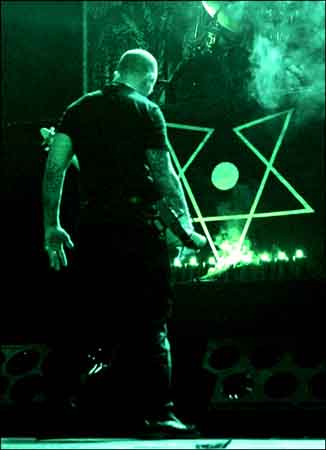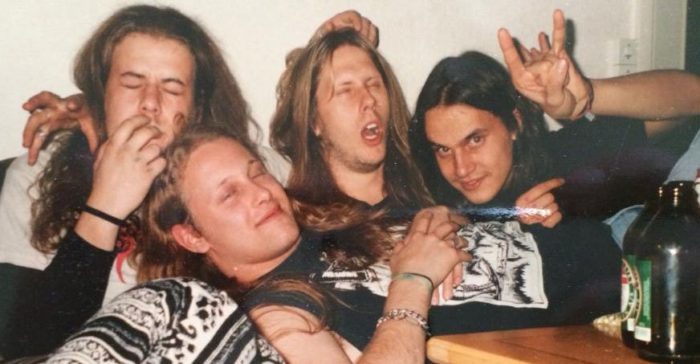Jon Nödtveidt opted out of an insane world
Jon Nödtveidt is dead and the response to his suicide diagnoses why he did it. As an acquaintance of mine said, “I’m of higher than average intelligence — two standard deviations. This society is not designed for people of higher intelligence. We see things the others don’t, such as how inefficient or self-destructive the way this society works is. And since they don’t see it, they crowd out our opinions and leave us with no voice. It’s a lonely side of life.”
For the child born with intelligence, the invisible world becomes clear: the connection between ideas and consequences both immediate and long term. This has to be trained by experience, but it emerges over time (one great lament of humanity is that it takes almost four decades for wisdom to emerge in most). Such a child will literally “see” things that do not exist but which will exist because he or she understands the connection between design (our thoughts, plans, goals) and their consequences.

The higher intelligence gives this person the ability to see multiple levels of consequence. Where a dumb person can realize that setting a blaze in a living room will burn the house down, and an average person will recognize the blaze may spread to a neighborhood, the reasonably above average person weighs the dryness of the season, the amount of loose timber in the neighborhood, prevailing winds and many other factors and can see how if the situation is right this fire could torch a large section of the surrounding city.
Of course, it’s an impossible task to explain this to an angry mob wanting to torch the house of a perceived enemy; they see only the immediate and tangible, which is their desire. Their brains lack the circuits to see broader implications, so even if these are painstakingly explained, they shout out their contrarian “opinions” which are as uninformed as they are blind to the question itself. They will not care about what they do not understand, and they understand little more than a single house ablaze.
In our modern time this tendency is amplified. The masses see only that they can afford things they want and with the tendency of all crowds, confuse pleasure/comfort/stability with doing what is right to provide for the future. In fact, they don’t consider the future; most people have a consciousness span of about two weeks and beyond that are lost to consequence as well as memory. For someone with a greater span of prediction and recall speaking to such people is like shouting into the wind at someone speaking a foreign language.
The intelligent people among us have warned us for some time: there are too many people empowered by technology (Kaczynski); the cruder and dumber masses have seized political control from the more intelligent and through a policy of revenge will destroy all intelligent things (Nietzsche); the vast masses will pursue pleasure and create a sterile but safe world (Huxley); the interconnectedness of all things, including design, is blindness in most people and thus they confuse symbol with reality (Schopenhauer); people misdiagnose their problem as existential when it is instead a lack of commitment to loving consciousness itself (Mary Shelley); most people confuse preference with consequence (Plato); people commonly misunderstand good relative to a bad goal as good relative to the question of survival with grace (Aristotle); people confuse wealth with nobility (Fitzgerald); people confuse personal power with an enduring connection to their world through heroism (Hemingway); the masses mistake “progress” in the physical world for rising above its privations (Faulkner). The list would actually extend far past the length of this essay if each great thinker in history was enumerated.
Let us return to the case of Jon Nodtveidt. Smarter than most, he produced a groundbreaking heavy metal album, “The Somberlain,” while still in his teenage years. While he made mistakes after that regarding the direction of his art, he never let the quality slip, and returned with a somewhat insubstantial but musically beautiful album, “Reinkaos.” Clearly he lost philosophical direction, but the experiences of the past decade might well have injected confusion into his worldview. Whether or not he found a personal direction, he could not purge his knowledge of the invisible world from his mind.
The invisible world facing humanity is this: taking advantage of the ideological and religious confusion of the past two millennia, the group of people that Michael Crichton calls “thin intelligences” — able to perform tasks requiring intelligence but blind to the implications and development of those ideas — seized power. Their implements of control: the use of money alone to determine the fitness of an idea; the use of popularity to determine culture; the use of democracy to let the broadest segment of the population outshout the smarter ones. The consequences of their control is a ship without a captain, or more accurately, a captain who tells the passengers what they want to hear regardless of the truth.
The result will be disastrous. Since every piece of land (with less than 5% of the world’s open space excepted by governments who can later rescind those decisions) for sale, and no check on human expansion except the relatively low cost of breeding, humanity will spread like poured cement into every available space. Fences go up, and this kills off the native species of the forest that need to roam; food needs mean the oceans will soon be depleted of edible fish, the land denuded with agriculture, and high concentrations of pesticides and industrial pollutants will enter the environment.
Culture, for sale, will become cosmopolitan, and people from all over the world will flood into every city and mix with the people there, producing a cultureless heritageless grey race who speak whatever language is most popular. High art dies and is replaced by popular “art” (Britney Spears) and boutique art, which pretends to be high art so those who need novelty can purchase something “unique” (Turbonegro). Jobs that reward smart people are replaced by those where the workers are interchangeable parts controlled by huge networks of rules and deskbound bureaucrats. Freedom will be spoken of widely, but will not exist as the high cost of living will tie people to jobs of which speaking an offensive truth might cause deprivation.
This is the future, unless something changes. This is the future where the average intelligences rule over the above average. Someone like Jon Nödtveidt is likely to give this kind of world a shot for awhile, but to always love the thought of escape as it means no longer having to live the lie of riding an apocalypse-bound train with no engineer. For the intelligent, the doom to our existence is always visible, while it is invisible to the average person, and it should not surprise us that so many take their lives instead of passively accepting the inevitable failure of humanity.
No CommentsTags: dissection, jon nodtveidt, suicide




